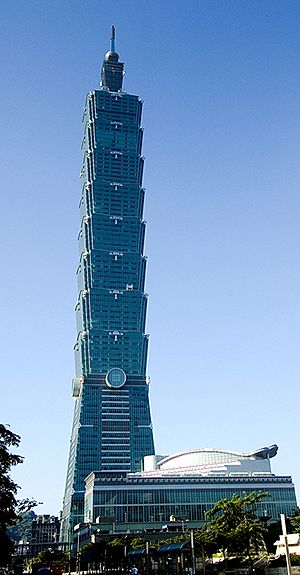Wind engineering facts for kids
Wind engineering is a special type of engineering. It studies how strong winds can affect buildings and other structures. Engineers want to make sure buildings are safe and comfortable for the people inside them, even when the wind blows very hard. They look at how wind might cause damage or make a building shake too much.
This field is very important, especially in places where there are strong storms like tornadoes or hurricanes. These extreme winds can cause a lot of damage, so wind engineers work to design buildings that can stand up to them.
Contents
What is Wind Engineering?
Wind engineering is all about understanding how wind interacts with things we build. Imagine a tall skyscraper or a long bridge. When strong winds hit them, they can push, pull, and even twist these structures. Wind engineers study these forces to make sure buildings are safe and don't get damaged.
They also think about how wind affects people inside buildings. If a building sways too much, it can make people feel sick or uncomfortable. So, engineers try to design buildings that are stable and don't move around too much in the wind.
Why is Wind Engineering Important?
Wind can be very powerful. It can cause problems for buildings in several ways:
- Damage: Very strong winds, like those in a hurricane or tornado, can rip off roofs, break windows, and even knock down entire structures. Wind engineers help design buildings to resist these forces.
- Discomfort: Even if a building doesn't break, strong winds can make it sway or vibrate. This can be uncomfortable for people inside, especially in very tall buildings. Engineers work to reduce this movement.
- Safety: Beyond the building itself, wind can affect things around it, like signs or outdoor structures. Wind engineering helps make sure these are also safe.
How Do Wind Engineers Work?
To understand wind, engineers use knowledge from many different science and engineering areas. They combine ideas from:
- Meteorology: This is the study of weather and wind patterns. Engineers need to know how strong winds usually get in different places.
- Fluid Dynamics: This science looks at how liquids and gases (like air) move. It helps engineers understand how wind flows around buildings.
- Mechanics: This is about how forces affect objects. Engineers use it to calculate how much force the wind puts on a building.
- Aerodynamics: This is a special part of fluid dynamics that focuses on how air moves around objects, like how wind moves around a building.
- Structural Dynamics: This field studies how structures move and vibrate when forces, like wind, act on them.
Tools Wind Engineers Use
Wind engineers use special tools and methods to test their designs:
- Wind Tunnels: These are large tunnels where engineers can create controlled wind conditions. They put small models of buildings inside the tunnel to see how wind affects them. This helps them test different shapes and designs.
- Computer Models: Engineers use powerful computers to create virtual models of buildings and wind. These models can simulate how wind will behave around a structure, helping them predict problems before building anything. This is called Computational Fluid Dynamics (CFD).
- Atmospheric Models: These are computer programs that help predict large-scale wind patterns and how wind behaves closer to the ground, which is called the atmospheric boundary layer.
By using these tools, wind engineers can design safer and more stable buildings that can stand up to even the strongest winds.
See also
 In Spanish: Ingeniería eólica para niños
In Spanish: Ingeniería eólica para niños


